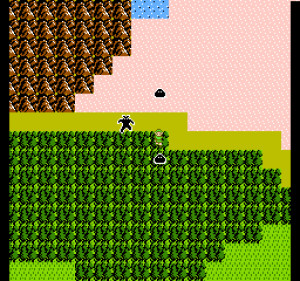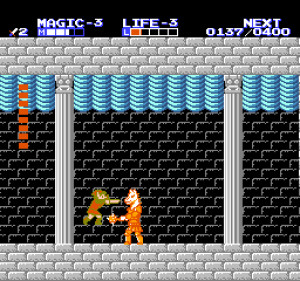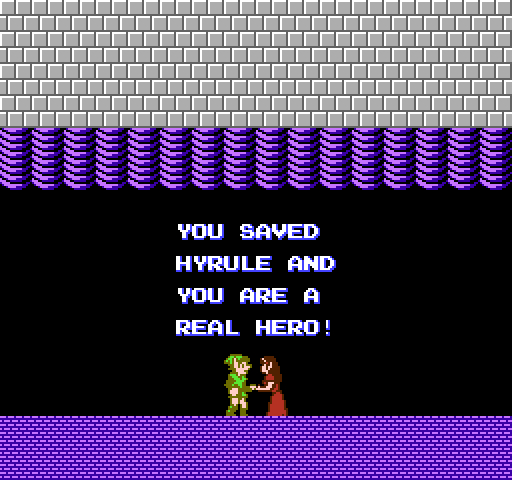In spite of what a certain, whimsically-named Australian may declare from deep within the entanglement of a sudsy, beer-afflicted worldview, Zelda II: The Adventure of Link is a bad game. Moreover, it is one of the worst games ever misrepresented as a great game. Zelda fans may claim that it is misunderstood; they may claim that critique of it has to do with reading modern expectations onto a title released in 1987; they may claim that disappointment stems from it being different than the original The Legend of Zelda. In that latter point alone they can be accused of having hit upon the edge of a corner of a shard of the truth. For, there are obviously great differences between the two titles, and the greatest difference of all is that The Legend of Zelda is a good game.
When the game begins, Link finds himself standing before Zelda, who is asleep on a bed. Walking out into the world, directionless, he may wander hither and yon seeking some method of advancement or guidance in his quest to wake the sleeping princess. However, the restricted capacity of NPC text means that anyone Link encounters will provide, at best, only vague and cryptic advice. Many players, befuddled by the formless nature of Link’s quest, quit the the game at an early stage–oh, fortunate, happy players!–never progressing beyond the first palace.
But if one is burdened with the task of finishing the game at all costs, and if one is similarly burdened with a bevy of staff members bearing poorly-written FAQs from the internet, then excuses about a lack of direction simply will not do. And, consequently, my investigation of the game progressed apace for the first time in five years, when this reviewer last played and completed the title. Surprisingly, despite the entirely negative memory of that experience, this most recent playthrough of Zelda II managed to be even more aggravating, frustrating, and genuinely horrible.
Zelda II may be a directionless wanderfest, but the actual difficulty of the game stems from the primitive RPG-style experience system combined with enemy encounters. Enemies, when first encountered, tend to be very difficult. Orange knights, for example, attack at two heights, and Link must be standing or ducking in order to parry the thrust properly. Red knights are the same, except faster, requiring white-knuckle, split-second reflexes in order to avoid taking significant damage. Finally, Blue Knights are not only faster and stronger, but their attacks are ranged, so they can hit Link at a great distance, making even advancing towards these foes incredibly irritating (the knights often endeavour to stand just out of the range of Link’s pathetic butter knife).
Spoon-throwing mumu-clad men hurl scarlet flatware at Link as he runs through caverns and palaces filled with Stalfos (skeletons) and Bots (slimes). Pursued still farther, he will encounter floating head enemies of the sort found in Mario and Castlevania games, and at the end of his adventure will additionally encounter–inexplicably–Bird Men, who tumble through the air with circus-like aplomb, hurling daggers whilst remaining infuriatingly impenetrable to the weary thrusts of the green-clad Hylian. Without the assistance of rapid-loading save states or a rewind feature, Zelda II would be an exercise in anger-management, with players of a choleric disposition likely surrounded by the wreckage of many controllers, shattered in a pique of rage.
In a stark contrast with the monsters found in the course of exploration, the boss encounters in Zelda II tend towards being very easy, with each fight having an exploitable mechanic. Carrock (Giant Wizzrobe) is the easiest of the lot, and can be defeated simply by kneeling in a corner and reflecting its attacks back at it until it dies. The most difficult fights are those which are most similar to difficult enemy encounters: the Knight on Horseback, for example, is very easy whilst mounted–but, when dismounted, becomes simply another annoying Blue Knight, which must be defeated with split second reflexes, and quite a bit of luck, to avoid damage. Consequently, the difficulty of the game pitches and yaws more than storm-tossed ship: this reviewer had to repeat a temple because the traversing thereof left insufficient life to complete the boss fight–but the boss fight itself was quite easy at full life. And, in a move reminiscent of Deadly Towers, Zelda II brings back the concept of reappearing enemies that can hit Link the moment he walks through a door.
The graphics of Zelda II are roughly average for 1987. All areas of gameplay tend to be visually repetitive, but this was not uncommon in 1987 (although better had certainly been achieved on the NES by that point). A similar explanation will suffice for the music: the anthems employed are aurally interesting, but their repetition and a lack of diversity in the soundtrack means that even the best themes (the temple music) quickly overstay their welcome–especially given the amount of time that must be spent, occasionally, in a single area. This reviewer spent more than an hour in some of the temples–upwards of two hours in one–and the music, on repeat throughout, had the shine knocked right off of it.
The storyline–traditionally a focus of later Zelda games–suffers a lack of development: there is no story to carry the player through the experience. Like the original The Legend of Zelda, the sequel is a series of dungeons which must sustain the story delivered in a scrolling introduction on the title screen. This was understandable in the original game, which had no towns and few NPCs with whom to interact. But in the sequel, it makes less sense: there are numerous towns and scores of NPCs, and yet no one seems even remotely interested in the curse that afflicts their princess. Instead, Link dutifully performs the task cusorily assigned to him in the introduction, and this alone must carry the player though a long, difficult, and tiresome experience.
Many games from the NES era have not aged well. Zelda II disappointed players when it was originally released and, nearly thirty years later, little has changed: lacking the sophistication of design found in other Zelda series games, and with a style of gameplay that focuses attention upon the game’s shortcomings, rather than a style that would minimise those drawbacks, Zelda II: The Adventure of Link remains a bad game in design if not in execution. Diehard fans of the Zelda series may be content to heap praise upon Zelda II without ever actually having to shift their arses and play the game themselves, but the simple reality is that the experience is not only tiresome, but–no thanks to the game’s incredibly short ending sequence!–deeply unfulfilling as well. There are plenty of Zelda adventures worth experiencing, but The Adventure of Link is best left unexplored.



